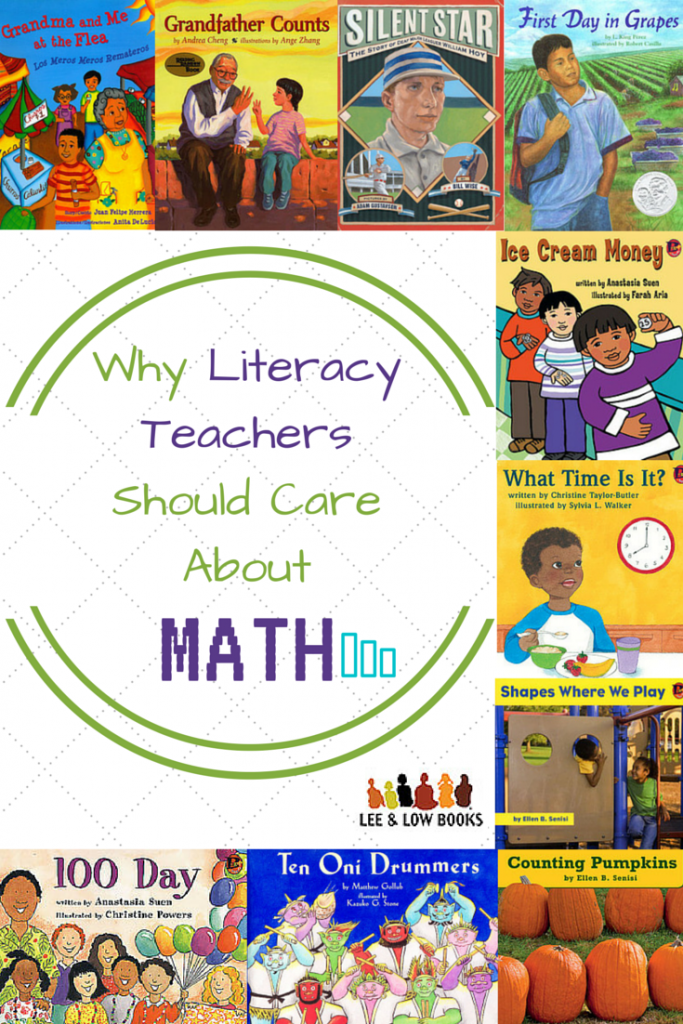I’ll be the first to admit it: I didn’t pay much attention to math. I specialized in literacy and focused on reading, speaking, listening, writing, social studies, and science instruction. Math? My third graders went down the hall each day to the “math classroom.” My co-teacher and I collaborated over best teaching practices, family relationships, and classroom management, but I didn’t spend time delving into the third-grade mathematics standards.
It wasn’t until I entered into our first parent-teachers-student conferences in September that I realized I couldn’t afford to compartmentalize my students’ learning.
In those conferences, we had students who loved math and had excelled in math every year leading up, but were now struggling to advance. They seemed to have hit an invisible wall. What happened?
Two words: Word problems.
 Some of our students who were English Language Learners, reluctant readers, or who struggled to read at grade level for other reasons all of a sudden “couldn’t do” math anymore because the vocabulary, text length, and sentence structure were increasing in complexity. Even though they knew what 9 x 5 was, they couldn’t read and decipher the sentence:
Some of our students who were English Language Learners, reluctant readers, or who struggled to read at grade level for other reasons all of a sudden “couldn’t do” math anymore because the vocabulary, text length, and sentence structure were increasing in complexity. Even though they knew what 9 x 5 was, they couldn’t read and decipher the sentence:
Rene enjoys wearing a new outfit every day. His father bought him nine pairs of shorts and five shirts. Rene doesn’t want to wear any outfit twice. How many different outfit combinations does he have?
Now several of my students weren’t only struggling to read in my literacy class, but also struggling to read in math class. This was disheartening and confusing for them because math was a subject they loved, excelled at, and didn’t feel “below their grade level” because of language abilities or background schema. Yet reading challenges were following them down the hall and across instruction periods.
Guess what: Reading teachers are ALSO math teachers.
What?
Let me explain.
- A text is a text no matter the form. Those ELA standards about determining the central idea and unknown or multiple-meaning words apply to word problems along with poems, plays, and biographies. Word problems can be lengthy, involve two or more steps, and contain new and unknown vocabulary that require examining context clues to solve.
- Great English teachers improve students’ math scores. According to The Hechinger Report, researchers from Stanford and University of Virginia looked at 700,000 students in New York City in third through eighth grade over the course of eight school years. Results: Students of good English language arts teachers had higher than expected math scores in subsequent years.
- Starting in second-grade mathematics, students are reading, interpreting, and solving two-step and multi-step word problems. Even as early as kindergarten and first grade, students are encountering one-step word problems. Bottom line: If they can’t read, they will get left behind in math, too.
So, how can literacy teachers embrace math?
1. Nice to meet you, Math. I’m ELA. The Common Core website also falls victim to sequestering the ELA and math standards. Whether you teach both math and literacy or only one, compare the math standards to the ELA standards of your grade. Open two windows on your computer setting the Reading or Language standards of your grade side by side with the Operations & Algebraic Thinking standards for your grade. What do they have in common?
(Hint, hint: determining central idea of a text, interpreting unknown words or phrases, using context clues, and learning general academic and domain-specific words)
2. Share what read aloud or model text you are reading for the week or unit if you have a separate teacher for math instruction. In word problems, you or the math instructor can write a few of the problems about the characters. Reading In Her Hands: The Story of Sculptor Augusta Savage? Make Augusta the main character in the word problems.
 This book has several money references because Augusta earned money from her teaching and from competitions she entered. Use some of the scenes in the book to review the values of currency. For example, Augusta earned a dollar every day from the principal of her school. How many different ways can you make $1.00 using combinations of quarters, dimes, nickels, and pennies?
This book has several money references because Augusta earned money from her teaching and from competitions she entered. Use some of the scenes in the book to review the values of currency. For example, Augusta earned a dollar every day from the principal of her school. How many different ways can you make $1.00 using combinations of quarters, dimes, nickels, and pennies?
3. Reward students with a math problem during the reading instruction block. (I’m telling you—students LOVE seeing you break out math during a literacy block). This gives students a break, uses a different part of their brains/thinking, and allows them to display their abilities in another subject (which is especially important if English makes a student feel doubtful or shy). Students can do this if they finish their required assignment early or you are transitioning between periods.
4. Allow students to create a word problem using the setting and characters of a book they are reading as an incentive, extension opportunity, or way to engage reluctant readers. Students can submit problems for you to review at the end of the day and the next day you can post one with the student author’s name. Students will have a chance to model (and observe) high quality writing and thinking, as well as delight in their peers’ recognition.
5. Word problems ARE story problems. Treat a word problem like any other fiction story. Have students identify the main character(s) and the problem. Give the word problem a setting. Encourage students to expand the math problem into a fiction story through writing or drawing.
6. Make a math bin in the classroom library. Whatever gets a student excited to read and pick up a book, right? Just as we will scour web deals and dig through yard sales for books on tiger sharks and poison dart frogs, don’t forget to hunt for math-themed books to add to your classroom library if math is your students’ passion.
7. Pick math-themed books to align with units students are covering in the grade level’s math standards. Great read alouds and leveled readers exist to help teach concepts around counting, money, time, geometry, and mixed operations, such as:
- 100 Day
- Counting Pumpkins
- Ice Cream Money
- Seven Cookies
- Shapes Where We Play
- Ten Oni Drummers
- Twenty-Two Cents
- What Time Is It?
8. Even books without explicit math themes can inspire math conversations.
 From Baby Flo: Florence Mills Lights Up the Stage:
From Baby Flo: Florence Mills Lights Up the Stage:
- Florence was promised twenty-five cents a night to perform at the Empire Theater. If she performed every night for one week, how much money did she earn? How much money would she earn in two weeks?
- After her performance in the butchers’ shop, Florence earned $3.85. How many nickels would you need to make $3.85? How many pennies would you need to make $3.85?
 From Silent Star: The Story of Deaf Major Leaguer William Hoy:
From Silent Star: The Story of Deaf Major Leaguer William Hoy:
- If Hoy was born in 1862 and died in 1961, how old was he when he passed away? If Hoy started playing in the major leagues in 1888 and retired from baseball in 1902, how many years did he play in the major leagues? How many years ago did Hoy last play baseball? If Hoy were alive today, how old would he be?
 From Love Twelve Miles Long:
From Love Twelve Miles Long:
- Frederick’s mother walks twelve miles. How many yards does she walk? How many kilometers and meters does she walk?
If students can’t read, they will struggle to succeed in math (and science and social studies). These challenges will compound with each year affecting self-confidence and commitment. Bridging math and literacy for students is a powerful way for students to see that learning how to derive meaning from text has real world applications and that you are invested in their entire education.
For further reading:
 Jill Eisenberg, our Senior Literacy Expert, began her career teaching English as a Foreign Language to second through sixth graders in Yilan, Taiwan as a Fulbright Fellow. She went on to become a literacy teacher for third grade in San Jose, CA as a Teach for America corps member. She is certified in Project Glad instruction to promote English language acquisition and academic achievement. In her column she offers teaching and literacy tips for educators.
Jill Eisenberg, our Senior Literacy Expert, began her career teaching English as a Foreign Language to second through sixth graders in Yilan, Taiwan as a Fulbright Fellow. She went on to become a literacy teacher for third grade in San Jose, CA as a Teach for America corps member. She is certified in Project Glad instruction to promote English language acquisition and academic achievement. In her column she offers teaching and literacy tips for educators.









